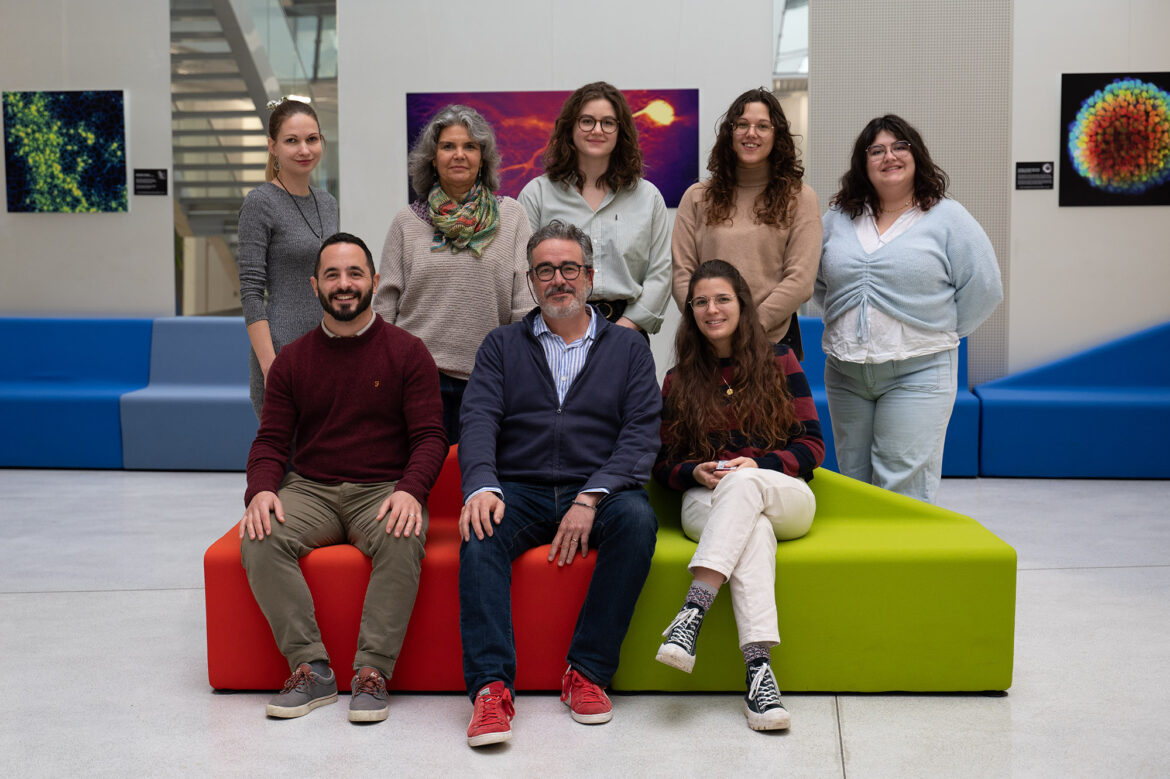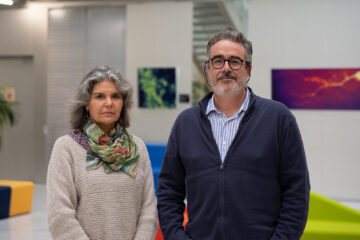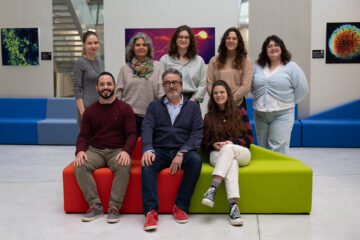
The SynTeam team co-directed by Francesca De Giorgi and François Ichas joins IMN
Since November 2023, IMN has been home to a new team, SynTeam (Integrative Neuropathology of a-Synucleinopathies), co-directed by François Ichas and Francesca De Giorgi Ichas. The team is interested in the structural, molecular and cellular bases of the replicative and neuroinvasive process of synucleinopathies.
Interview.
It’s often a long and eventful road to leading a team. Could you tell us more about your career paths?

Francesca De Giorgi Ichas and François Ichas: After obtaining a PhD in Biology and Molecular Pathology at the University of Padua in 2000, and a short post-doctoral period in the Mitochondrial Physiology team at the University of Bordeaux, Francesca was recruited as a research fellow at Inserm in 2000.
François defended his thesis at the University of Bordeaux in 1997, and after a post-doctorate in the Department of Biomedical Sciences at the University of Padua, thanks to a Human Frontier grant, he was recruited as a research fellow at Inserm in 1999.
It was in Padua that we began our scientific collaboration. Since then, we’ve always worked together. From 2000 to 2006, we led a research group at the Institut Européen de Chimie et Biologie in Bordeaux, which became an Inserm laboratory in 2003, with François as its director. In 2006, this laboratory moved to the Institut Bergonié, where it became one of the three departments of a new Inserm translational research unit until 2011.
At the same time, in 2003, in collaboration with Dr. Pier Vincenzo Piazza, we founded a service company which at the time was a pioneer in the use of high-content cell analysis methodologies, capable of carrying out research projects outsourced by the pharmaceutical industry. From 2011 to 2016, we put our work at Inserm on hold to devote ourselves full-time to this company, working on projects in a wide range of fields from oncology to cellular neurobiology. During this period of service to industry, we became involved in the neurosciences, and in particular in the dissection and identification of molecular mechanisms involved in certain neurodegenerative diseases linked to aggregative phenomena.
In 2017 we returned to our positions at Inserm with the new challenge of bringing our specific methodological skills to the study of neurodegenerative diseases caused by alpha synuclein deregulation and aggregation. Initially assigned to the LNEC in Poitiers, we quickly joined the IMN team headed by Erwan Bezard. Thanks to his support, we were able to develop our lines of research independently, and eventually set up our own independent research team.
Your team is interested in synucleinopathy. Could you define this pathology for us?
Pathological aggregation of neuronal proteins is a key and often causal event in many neurodegenerative diseases. Synucleinopathy, which corresponds to the accumulation and propagation in the brain of aggregated amyloid forms of a-synuclein, is observed in Parkinson’s disease (PD), multisystem atrophy (MSA) and Lewy body dementia. The molecular mechanisms underlying the amyloid self-assembly of this small synaptic protein, the cellular processes by which neurons take on its pathogenic conformational changes, and the interneuronal propagation pathways of aggregated forms are key aspects of the pathology and of great interest for therapeutic development. It is now well established that aggregated synuclein can self-perpetuate the pathological process by amplifying its own aggregation via a process similar to that described for prions. This prion-like aggregation mechanism could explain two key aspects of synucleinopathies: the progressive invasion of different brain areas by the pathology during the course of the disease (Braak’s hypothesis), and the variety of clinical presentations associated with the aggregation of a single protein, a variety which could be linked to the polymorphism of amyloid forms of a-synuclein.
Do you have a global approach to this pathology, or do you focus on specific aspects?
Our team is interested in the structural, molecular and cellular basis of the replicative and neuroinvasive process of synucleinopathies, using multiple experimental and analytical methodologies. On the one hand, the production or isolation of amyloid complexes to obtain structure-function information. On the other hand, the exploration of the propagation and analysis of cellular processes involved in the fate of aggregates on primary cultures of mouse cortical neurons and in vivo models by exposure to preformed fibrils of amyloid a-synuclein.
In particular, SynTeam is studying the molecular aspects differentiating PD and MSA, and the cellular mechanisms downstream of aggregation. Such “downstream” mechanisms could be at the origin of the specific presentation of MSA, through accumulation of synuclein in oligodendrocytes, and moreover, could determine the modalities of neuronal dysfunction and loss.

Can you introduce the other members of your team?
The other member of the SynTeam team is Florent Laferrière, CNRS research fellow. Florent has worked with us since our arrival at IMN, initially as a postdoctoral researcher and then after his recruitment in 2021 as a CNRS research fellow. With a background specializing in biochemical approaches to prion analysis and, more generally, amyloid assemblies, he has been a key player in forming the core of the team, enabling us collectively to draw on a panel of highly complementary approaches to answer questions concerning the pathogenic activity of synuclein amyloid complexes.
Two PhD students, Aenora Letourneur and Ludivine Sabatier, a post-doctoral researcher Marianna Kashyrina, a internship student from NeuroBIM Bordeaux, Anna Carla-Le Bastard, and an engineer on fixed-term contract, Hortense de La Seiglière, also work with us.
Which research teams do you collaborate with?
Henning Stahlberg and his PhD student Domenic Burger at the EPFL in Switzerland, to use cryoEM to uncover the structure-function relationships that explain the pathophysiological effects of amyloid synuclein assemblies. Dario Lofrumento of the Human Anatomy Laboratory at the University of Salento, Lecce (Italy) for the creation and analysis of a bank of brains from mice with experimental synucleinopathy.
In addition, we are working with Marion Psomiades, Elodie Angot and Markus Britschgi of Roche Laboratories to discover the mechanisms involved in amyloid swarming during the progression phase of synucleinopathies.
Finally, at IMN, we are collaborating with Arthur Leblois, to understand the impact of synuclein and its deregulation on the neuronal networks involved in learning, via an in vivo avian model of song acquisition.
Contacts
Recent publications
- Hruska-Plochan, M., Wiersma, V.I., Betz, K.M. et al. A model of human neural networks reveals NPTX2 pathology in ALS and FTLD. Nature (2024).
https://doi.org/10.1038/s41586-024-07042-7 - Francesca De Giorgi, Ænora Letourneur, Marianna Kashyrina et al. Reconsidering α-Synuclein inclusion pathology in neurons, mice, and humans with an antibody sensing NAC engagement during α-Synuclein amyloid conversion, 07 February 2024, PREPRINT (Version 1) available at Research Square
https://doi.org/10.21203/rs.3.rs-3921168/v1 - Oligodendrocytes Prune Axons Containing α-Synuclein Aggregates In Vivo: Lewy Neurites as Precursors of Glial Cytoplasmic Inclusions in Multiple System Atrophy?
Francesco De Nuccio, Marianna Kashyrina, Francesca Serinelli, Florent Laferrière, Dario Domenico Lofrumento, Francesca De Giorgi and François Ichas.
biomolecules. 2023-02-01. 13 (2) : 269.
DOI: 10.3390/biom13020269 - A Novel C-Type Lectin Receptor-Targeted α-Synuclein-Based Parkinson Vaccine Induces Potent Immune Responses and Therapeutic Efficacy in Mice
Sabine Schmidhuber, Sandra Scheiblhofer, Richard Weiss, Mihály Cserepes, József Tóvári, Gabriele Gadermaier, Erwan Bezard, Francesca De Giorgi, Francois Ichas, Dirk Strunk, Markus Mandler.
Vaccines. 2022-08-30. 10 (9) : 1432.
DOI: 10.3390/vaccines10091432 - α-Synuclein Fibrils as Penrose Machines: A Chameleon in the Gear
Francesca De Giorgi, Vladimir N. Uversky, François Ichas.
Biomolecules. 2022-03-24. 12 (4) : 494.
DOI: 10.3390/biom12040494 - Neurons with Cat’s Eyes: A Synthetic Strain of α-Synuclein Fibrils Seeding Neuronal Intranuclear Inclusions
Francesca De Giorgi, Muhammed Bilal Abdul-Shukkoor, Marianna Kashyrina, Leslie-Ann Largitte, Francesco De Nuccio, Brice Kauffmann, Alons Lends, Florent Laferrière, Sébastien Bonhommeau, Dario Domenico Lofrumento, Luc Bousset, Erwan Bezard, Thierry Buffeteau, Antoine Loquet, François Ichas.
Biomolecules. 2022-03-11. 12 (3) : 436.
DOI: 10.3390/biom12030436 - Similar neuronal imprint and no cross-seeded fibrils in α-synuclein aggregates from MSA and Parkinson’s disease
Florent Laferrière, Stéphane Claverol, Erwan Bezard, Francesca De Giorgi, François Ichas.
npj Parkinsons Dis.. 2022-01-13. 8 (1)
DOI: 10.1038/s41531-021-00264-w - Overexpression of α-Synuclein by Oligodendrocytes in Transgenic Mice Does Not Recapitulate the Fibrillar Aggregation Seen in Multiple System Atrophy
Florent Laferrière, Xin He, Federica Zinghirino, Evelyne Doudnikoff, Emilie Faggiani, Wassilios G. Meissner, Erwan Bezard, Francesca De Giorgi, François Ichas.
Cells. 2020-10-29. 9 (11) : 2371.
DOI: 10.3390/cells9112371 - Novel self-replicating α-synuclein polymorphs that escape ThT monitoring can spontaneously emerge and acutely spread in neurons
Francesca De Giorgi, Florent Laferrière, Federica Zinghirino, Emilie Faggiani, Alons Lends, Mathilde Bertoni, Xuan Yu, Axelle Grélard, Estelle Morvan, Birgit Habenstein, Nathalie Dutheil, Evelyne Doudnikoff, Jonathan Daniel, Stéphane Claverol, Chuan Qin, Antoine Loquet, Erwan Bezard, François Ichas.
Sci. Adv.. 2020-10-01. 6 (40) : eabc4364.
DOI: 10.1126/sciadv.abc4364 - Reduced oligodendrocyte exosome secretion in multiple system atrophy involves SNARE dysfunction
Zhenwei Yu, Min Shi, Tessandra Stewart, Pierre-Olivier Fernagut, Yang Huang, Chen Tian, Benjamin Dehay, Anzari Atik, Dishun Yang, Francesca De Giorgi, François Ichas, Marie-Hélène Canron, Roberto Ceravolo, Daniela Frosini, Han-Joon Kim, Tao Feng, Wassilios G Meissner, Jing Zhang.
Brain. 2020-05-18.
DOI: 10.1093/brain/awaa110 - TDP-43 extracted from frontotemporal lobar degeneration subject brains displays distinct aggregate assemblies and neurotoxic effects reflecting disease progression rates.
Florent Laferrière, Zuzanna Maniecka, Manuela Pérez-Berlanga, Marian Hruska-Plochan, Larissa Gilhespy, Eva-Maria Hock, Ulrich Wagner, Tariq Afroz, Paul J. Boersema, Gery Barmettler, Sandrine C. Foti, Yasmine T. Asi, Adrian M. Isaacs, Ashraf Al-Amoudi, Amanda Lewis, Henning Stahlberg, John Ravits, Francesca De Giorgi, François Ichas, Erwan Bezard, Paola Picotti, Tammaryn Lashley, Magdalini Polymenidou.
Nat Neurosci. 2018-12-17. 22 (1) : 65-77.
DOI: 10.1038/s41593-018-0294-y
Last update 29/02/24
